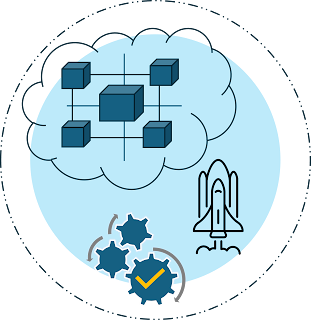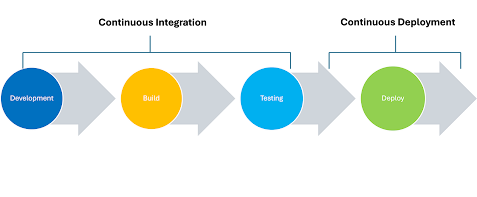OutSystems Deployment in the Cloud-Native Era: Trends and Best Practices
OutSystems Deployment in the Cloud-Native Era: Trends and Best Practices
Introduction

In today’s rapidly evolving technological landscape, integrating cloud-native principles with low-code platforms like OutSystems has become essential for organizations striving for agility, scalability, and resilience. As enterprises migrate workloads to the cloud, understanding the key trends and best practices for deploying OutSystems applications is crucial for optimizing performance and cost efficiency. This article explores the growing adoption of OutSystems in cloud-native environments and outlines essential deployment strategies for success.
Understanding Cloud-Native Computing
Cloud-native computing leverages microservices, containerization, Kubernetes orchestration, and DevOps methodologies to develop scalable, resilient, and highly available applications. These principles empower businesses to build applications optimized for cloud environments, ensuring adaptability to changing demands and business needs.
OutSystems supports cloud-native computing by offering features such as:
- Microservices Architecture: Enables modular, independent service deployment.
- Containerization: Supports Docker images for efficient application encapsulation.
- Kubernetes Orchestration: Enhances application scalability and reliability across multiple cloud platforms.
- Continuous Integration/Continuous Deployment (CI/CD): Automates deployment pipelines for streamlined releases.
Key Trends in OutSystems Cloud-Native Deployment
- Rise of Kubernetes and Containerization
Containerization and Kubernetes orchestration have revolutionized application deployment, enabling:
- Portability: Applications run consistently across development, testing, and production environments.
- Scalability: Resources adjust dynamically to accommodate varying workloads.
- Resilience: Automated container restarts and failover mechanisms ensure stability.
OutSystems facilitates containerized deployments by supporting Docker images and integrating with Kubernetes for automated scaling, load balancing, and seamless updates.
- Adoption of Hybrid and Multi-Cloud Strategies
To avoid vendor lock-in and enhance redundancy, organizations increasingly embrace hybrid and multi-cloud strategies. OutSystems enables seamless deployment across AWS, Azure, and Google Cloud, offering benefits such as:
- Flexibility: Deploy applications where they deliver the greatest business value.
- Redundancy: Mitigate risks associated with provider outages.
- Cost Optimization: Select cloud resources that align with workload demands.
- Security-First Deployments
Security remains a top priority in cloud-native deployments. OutSystems enhances security through:
- Secure Authentication: Multi-factor authentication and identity provider integration.
- Access Control: Role-Based Access Control (RBAC) and Attribute-Based Access Control (ABAC).
- Compliance Standards: Adherence to OWASP guidelines and ISO certifications.
- Data Encryption: Protecting data in transit and at rest.
Additionally, cloud-native security tools like AWS Shield and Azure Security Center provide extra layers of protection.
- Serverless Computing Integration
Serverless frameworks reduce infrastructure management overhead. By integrating OutSystems with AWS Lambda or Azure Functions, organizations benefit from:
- Cost Efficiency: Paying only for used compute resources.
- Rapid Deployment: Enabling event-driven architectures.
- Operational Simplicity: Eliminating server and VM management complexities.
- Shift-Left Testing
The shift-left testing approach—executing tests early in development—enhances software quality. OutSystems integrates testing tools within development workflows, enabling:
- Early Defect Detection: Resolving issues before they escalate.
- Automated Testing: Utilizing Selenium and TestProject for comprehensive validation.
- CI/CD Alignment: Running automated tests during builds and deployments.
Best Practices for Deploying OutSystems in Cloud-Native Environments

- Design for Scalability and Resilience
To ensure adaptability and robustness:
- Microservices Architecture: Build modular, independent application components.
- Load Balancing: Use Kubernetes or cloud-native tools to distribute traffic efficiently.
- Redundancy Measures: Deploy applications across multiple availability zones or regions.
- Implement DevOps and CI/CD
DevOps practices accelerate deployments and maintain software quality. OutSystems supports DevOps through:
- Version Control: Managing application versions via OutSystems Lifetime.
- Automated CI/CD Pipelines: Streamlining code integration, testing, and deployment.
- Monitoring Solutions: Tracking application health with built-in and external monitoring tools.
- Optimize Cloud Costs
To enhance cost efficiency:
- Dynamic Resource Allocation: Adjust computing resources based on demand.
- Resource Monitoring: Use Azure Monitor or AWS CloudWatch for cost tracking.
- Reserved Instances: Reduce expenses through long-term cloud resource commitments.
- Prioritize Security
Security should be embedded in every deployment stage:
- Secure Communication: Use HTTPS and TLS for data transmission.
- Access Management: Implement RBAC and integrate with Identity Providers (IdPs).
- Regular Updates: Keep applications and dependencies up to date.
- Enhance Observability
Visibility into application performance is essential for reliability. Best practices include:
- Comprehensive Logging: Capturing detailed logs for issue resolution.
- Performance Metrics: Monitoring key indicators like response times and error rates.
- Distributed Tracing: Using tracing tools to track service interactions.
- Automate Infrastructure Management
Using Infrastructure as Code (IaC) tools like Terraform ensures efficient infrastructure oversight:
- Consistency: Standardizing deployments across environments.
- Efficiency: Automating repetitive infrastructure tasks.
- Scalability: Scaling infrastructure seamlessly as applications grow.
- Conduct Regular Performance Assessments
Ongoing performance evaluation helps identify inefficiencies. Recommended methods include:
- OutSystems Performance Tools: Analyzing application health and user interactions.
- External APM Solutions: Leveraging tools like Datadog and AppDynamics.
- User Feedback: Incorporating insights to enhance functionality.
Case Study: OutSystems Cloud-Native Deployment Success
A financial services company faced challenges with legacy systems, including sluggish performance and high costs. By deploying OutSystems applications on AWS, the company achieved:
- Enhanced Scalability: Kubernetes autoscaling handled peak traffic seamlessly.
- Cost Savings: Cloud optimization reduced infrastructure expenses by 30%.
- Performance Boost: Transaction processing speeds improved by 40%.
- Stronger Security: Advanced IAM policies ensured regulatory compliance.
- Streamlined Operations: Automated CI/CD pipelines reduced deployment time significantly.
Conclusion
OutSystems, combined with cloud-native strategies, empowers businesses to develop, deploy, and scale applications efficiently. By adopting trends like Kubernetes, hybrid cloud, and serverless computing, organizations can maximize the benefits of cloud-native deployments. Implementing these best practices ensures successful, secure, and cost-effective application management in modern cloud environments.
References
- OutSystems Official Documentation. Available at: https://success.outsystems.com/documentation/11/deploying_apps/
- Kubernetes Documentation. Available at: https://kubernetes.io/docs/home/
- AWS Well-Architected Framework. Available at: https://aws.amazon.com/architecture/well-architected/
- Azure DevOps Best Practices. Available at: https://learn.microsoft.com/en-us/azure/devops/
- OWASP Foundation Security Practices. Available at: https://owasp.org/
- New Relic Performance Monitoring. Available at: https://newrelic.com/platform
- Terraform by HashiCorp. Available at: https://www.terraform.io/
